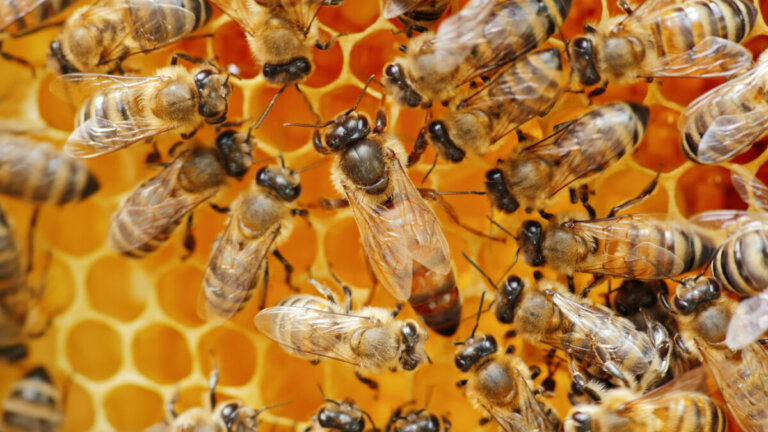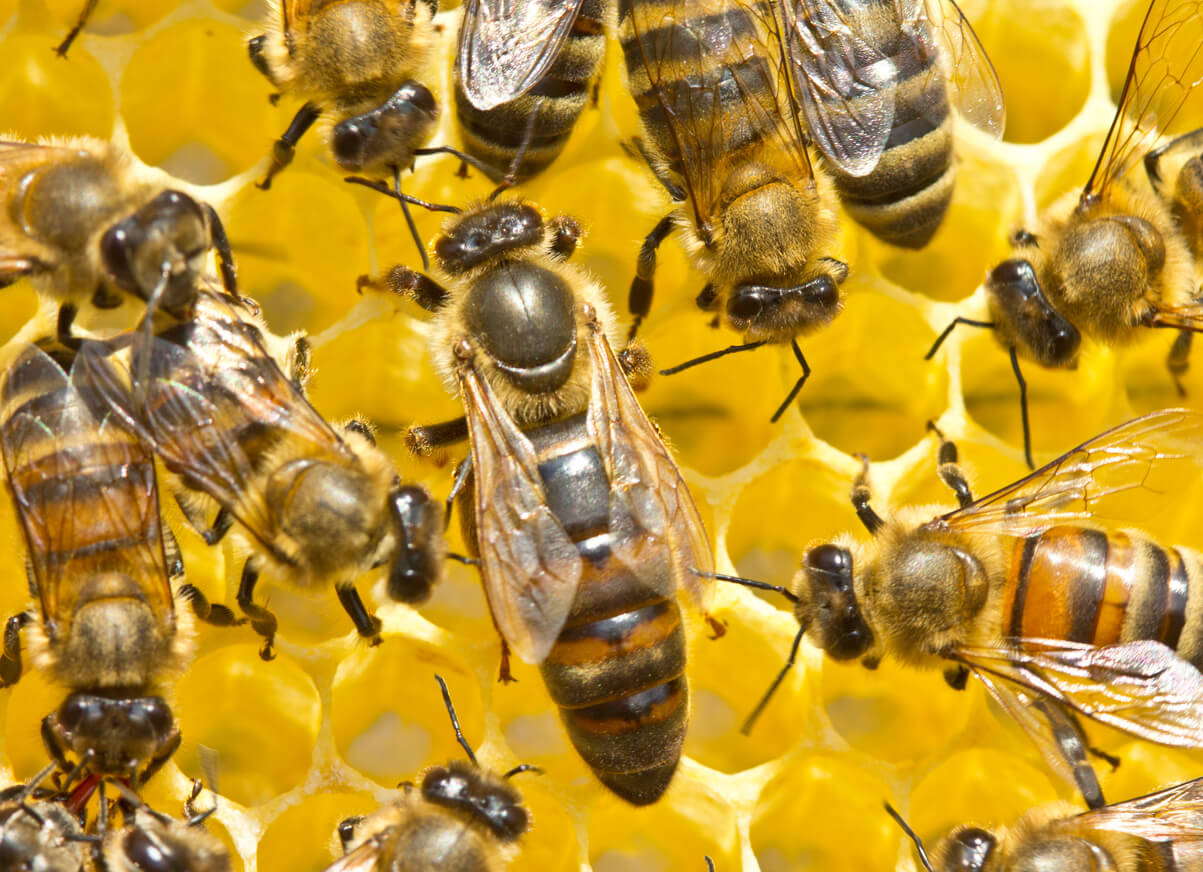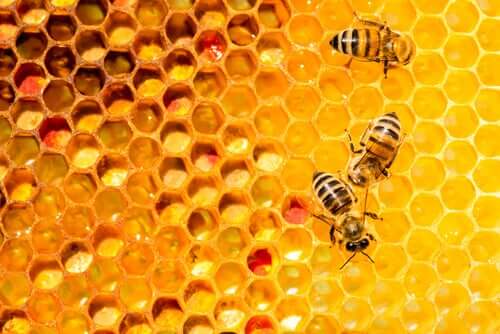The Queen Bee: Functions and Behavior in the Hive


Written and verified by the psychologist Sara González Juárez
The intelligence of bees is more significant as a group than as individuals, and the queen bee is the central axis of the functioning of this hive mentality. Her functions are irreplaceable. So, if you want to know more about these insects, keep reading. You’re sure to be surprised!
As a fundamental pillar of the social organization of this superorganism, the queen bee hierarchizes, repopulates, and guides the hive. Let’s get to know the fascinating occupations she has and what would happen if she were to disappear. Don’t miss a single detail.
What are the roles of the queen bee?
The queen bee is the only member of her caste within the three that are found in the colony: The queen, drones, and workers. Her main functions are the following:
- Reproduction: She’s the only fertile female in the swarm, so she’s the mother of all the others. After a nuptial flight in which she mates with the drones of the hive, the queen stores the sperm in a cavity called the “spermatheca,” which will allow her to lay fertilized eggs for 3-5 years. Unfertilized eggs – produced by parthenogenesis – will give life to new drones.
- Social organization: The queen bee emits pheromones that affect the brain chemistry of the other members of the hive. With these pheromones, she’s able to produce submission, order the attack of an invader, or even get the other bees to groom her. However, the effects of these pheromones are still under study, as they seem to vary from one context to another, and a scientific consensus is still needed.
Why is there one queen bee?

The aforementioned pheromones from the queen also have an additional effect on the worker bees: They inhibit their reproductive capacity. In fact, their reproductive system fails to develop properly. In this way, the population of the hive is controlled, and the task of reproduction falls directly on the queen.
In fact, the only time when there’s more than one queen bee in the hive is when the queen begins to perform poorly, whether due to old age, illness, or other reasons. At that point, the workers begin to build queen cells – sized to fit the larger adult queen – and also feed several larvae with royal jelly to raise new queens.
When the queen’s mandibular pheromone begins to decrease, the bees detect that she’s no longer fit to perform her tasks.
How is the queen bee chosen?
Once the colony has decided that it’s time to replace the queen bee, queen cells are built, and larvae are fed with royal jelly, as discussed above. In these cells, the larvae will become larger bees, without a suction organ and with a longer abdomen. Their visual system is different, as is their gastrointestinal microbiome. This is shown in a paper reported in PLOS ONE.
Royal jelly has the ability to alter the DNA of the larvae, turning them into this fertile specimen. Once these larvae reach the adult stage, they’ll fight to the death, and the strongest one will become the queen bee. If there’s already a queen bee, the youngest one will expel her and take her place.
What happens if there’s no queen?
When the queen bee dies before the workers can create others, the latter, free of the pheromone that inhibits their reproductive capacity, eventually begin to lay eggs.
Therefore, the orphaned colony becomes a stilt colony, as only males will hatch from these unfertilized eggs.
At other times, the hive harbors more bees than it can handle. In these circumstances, the queen bee leaves the hive with some of her workers to build a new hive in another location. This isn’t an orphan colony, as the workers would have time to raise a new generation of queens and don’t lay eggs.
Who takes care of her?
The queen bee receives her care from the workers. In fact, she never gets to taste pollen or see sunlight, except when she makes her nuptial flight or leaves to establish another colony. She lives inside the hive, and the younger bees are in charge of bringing her food, grooming her, and protecting her.
Does the queen give orders?
The term “queen bee” seems to indicate that this figure gives orders to her subjects as if she were a human monarch. However, her role is reproductive, and the only influence she has over the workers is through her pheromones.
This influence is limited to “asking” for certain attention, such as food, protection, or cleanliness (in addition to inhibiting reproductive functions).
This makes her a key player in the survival of the colony, but it doesn’t give her the power of command. Workers work tirelessly to keep the colony alive and repair the hive through the division of roles.
In general, the age of bees is what determines their roles: The younger bees perform tasks inside the hive, where they’re safer, and the veterans are those who venture out in search of food. However, genetics also plays a role in the organization of tasks, as indicated in a study published in the journal Trends in Genetics.

Can the queen be replaced?
As far as her functions are concerned, the answer is no. No worker bee can take over the role of the queen bee. No worker bee can take her place, even if she starts laying eggs. Remember that the queen bee has a different genotype, thanks to the royal jelly she was fed during her larval stage.
At the same time, it’s not possible to replace her with a foreign queen. The workers would detect her scent and expel her from the colony, so she wouldn’t be able to stay or “conquer” the hive.
The only way to replace a queen bee with another one that performs her functions is, as explained above, for the workers to raise a new generation. The purpose of this measure is to ensure that the colony lasts.
The queen bee: A world of mystery
Did you know all these facts about the queen bee and her functions? The truth is that the more we know about these hymenopterans, the more questions that arise. What more secrets will we be able to unravel?
The intelligence of bees is more significant as a group than as individuals, and the queen bee is the central axis of the functioning of this hive mentality. Her functions are irreplaceable. So, if you want to know more about these insects, keep reading. You’re sure to be surprised!
As a fundamental pillar of the social organization of this superorganism, the queen bee hierarchizes, repopulates, and guides the hive. Let’s get to know the fascinating occupations she has and what would happen if she were to disappear. Don’t miss a single detail.
What are the roles of the queen bee?
The queen bee is the only member of her caste within the three that are found in the colony: The queen, drones, and workers. Her main functions are the following:
- Reproduction: She’s the only fertile female in the swarm, so she’s the mother of all the others. After a nuptial flight in which she mates with the drones of the hive, the queen stores the sperm in a cavity called the “spermatheca,” which will allow her to lay fertilized eggs for 3-5 years. Unfertilized eggs – produced by parthenogenesis – will give life to new drones.
- Social organization: The queen bee emits pheromones that affect the brain chemistry of the other members of the hive. With these pheromones, she’s able to produce submission, order the attack of an invader, or even get the other bees to groom her. However, the effects of these pheromones are still under study, as they seem to vary from one context to another, and a scientific consensus is still needed.
Why is there one queen bee?

The aforementioned pheromones from the queen also have an additional effect on the worker bees: They inhibit their reproductive capacity. In fact, their reproductive system fails to develop properly. In this way, the population of the hive is controlled, and the task of reproduction falls directly on the queen.
In fact, the only time when there’s more than one queen bee in the hive is when the queen begins to perform poorly, whether due to old age, illness, or other reasons. At that point, the workers begin to build queen cells – sized to fit the larger adult queen – and also feed several larvae with royal jelly to raise new queens.
When the queen’s mandibular pheromone begins to decrease, the bees detect that she’s no longer fit to perform her tasks.
How is the queen bee chosen?
Once the colony has decided that it’s time to replace the queen bee, queen cells are built, and larvae are fed with royal jelly, as discussed above. In these cells, the larvae will become larger bees, without a suction organ and with a longer abdomen. Their visual system is different, as is their gastrointestinal microbiome. This is shown in a paper reported in PLOS ONE.
Royal jelly has the ability to alter the DNA of the larvae, turning them into this fertile specimen. Once these larvae reach the adult stage, they’ll fight to the death, and the strongest one will become the queen bee. If there’s already a queen bee, the youngest one will expel her and take her place.
What happens if there’s no queen?
When the queen bee dies before the workers can create others, the latter, free of the pheromone that inhibits their reproductive capacity, eventually begin to lay eggs.
Therefore, the orphaned colony becomes a stilt colony, as only males will hatch from these unfertilized eggs.
At other times, the hive harbors more bees than it can handle. In these circumstances, the queen bee leaves the hive with some of her workers to build a new hive in another location. This isn’t an orphan colony, as the workers would have time to raise a new generation of queens and don’t lay eggs.
Who takes care of her?
The queen bee receives her care from the workers. In fact, she never gets to taste pollen or see sunlight, except when she makes her nuptial flight or leaves to establish another colony. She lives inside the hive, and the younger bees are in charge of bringing her food, grooming her, and protecting her.
Does the queen give orders?
The term “queen bee” seems to indicate that this figure gives orders to her subjects as if she were a human monarch. However, her role is reproductive, and the only influence she has over the workers is through her pheromones.
This influence is limited to “asking” for certain attention, such as food, protection, or cleanliness (in addition to inhibiting reproductive functions).
This makes her a key player in the survival of the colony, but it doesn’t give her the power of command. Workers work tirelessly to keep the colony alive and repair the hive through the division of roles.
In general, the age of bees is what determines their roles: The younger bees perform tasks inside the hive, where they’re safer, and the veterans are those who venture out in search of food. However, genetics also plays a role in the organization of tasks, as indicated in a study published in the journal Trends in Genetics.

Can the queen be replaced?
As far as her functions are concerned, the answer is no. No worker bee can take over the role of the queen bee. No worker bee can take her place, even if she starts laying eggs. Remember that the queen bee has a different genotype, thanks to the royal jelly she was fed during her larval stage.
At the same time, it’s not possible to replace her with a foreign queen. The workers would detect her scent and expel her from the colony, so she wouldn’t be able to stay or “conquer” the hive.
The only way to replace a queen bee with another one that performs her functions is, as explained above, for the workers to raise a new generation. The purpose of this measure is to ensure that the colony lasts.
The queen bee: A world of mystery
Did you know all these facts about the queen bee and her functions? The truth is that the more we know about these hymenopterans, the more questions that arise. What more secrets will we be able to unravel?
All cited sources were thoroughly reviewed by our team to ensure their quality, reliability, currency, and validity. The bibliography of this article was considered reliable and of academic or scientific accuracy.
- Beggs, K. T., Glendining, K. A., Marechal, N. M., Vergoz, V., Nakamura, I., Slessor, K. N., & Mercer, A. R. (2007). Queen pheromone modulates brain dopamine function in worker honey bees. Proceedings of the National Academy of Sciences, 104(7), 2460-2464. https://www.pnas.org/doi/abs/10.1073/pnas.0608224104
- Berenbaum, M. R., & Calla, B. (2021). Honey as a functional food for Apis mellifera. Annual Review of Entomology, 66, 185-208. https://www.annualreviews.org/doi/abs/10.1146/annurev-ento-040320-074933
- Kapheim, K. M., Rao, V. D., Yeoman, C. J., Wilson, B. A., White, B. A., Goldenfeld, N., & Robinson, G. E. (2015). Caste-specific differences in hindgut microbial communities of honey bees (Apis mellifera). PloS One, 10(4), e0123911. https://journals.plos.org/plosone/article?id=10.1371/journal.pone.0123911
- Lattorff, H. M. G., & Moritz, R. F. (2013). Genetic underpinnings of division of labor in the honeybee (Apis mellifera). Trends in Genetics, 29(11), 641-648. https://www.sciencedirect.com/science/article/abs/pii/S0168952513001418
- Wang, H., Liu, Z., Wang, Y., Ma, L., Zhang, W., & Xu, B. (2020). Genome-wide differential DNA methylation in reproductive, morphological, and visual system differences between queen bee and worker bee (Apis mellifera). Frontiers in Genetics, 11, 770. https://www.frontiersin.org/articles/10.3389/fgene.2020.00770/full
This text is provided for informational purposes only and does not replace consultation with a professional. If in doubt, consult your specialist.








